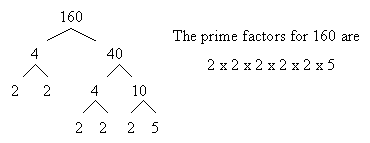Factors and Primes
Instruction
Factors and Primes
When two numbers are multiplied together they result in a product. The two numbers multiplied together are called factors. So for the equation 5 x 6 = 30. 5 and 6 are both factors, and 30 is the product.
A prime number is any counting number other than 1, that can only be divided by itself and 1. Examples of prime numbers are 1, 2, 3, 5, 7, 11, 13, 17, 19.
A composite number is any number that can be expressed as the product of two smaller numbers. The following are examples of composite numbers:
4 = 2 x 2
6 = 2 x 3
8 = 2 x 4 (or 2 x 2 x 2)
Every composite number can be written as a product of prime numbers. The process of determining the prime factors of a composite number is called factoring. Example:
16 = 2 x 2 x 2 x 2
60 = 2 x 2 x 3 x 5
75 = 3 x 5 x 5
Factor trees can help you determine the prime factorization. For example:

Peer Support
If you are having difficulty with the subject matter, there is always a great deal of support available to you from other members through the Forum. Simply do a search for the material you need help with (math, algebra, integers, etc.) Members are very supportive and helpful. Don't hesitate to post any questions, or provide answers to others seeking assistance.
Reducing Fractions
Work through the following tests to make sure you are comfortable with the material.



